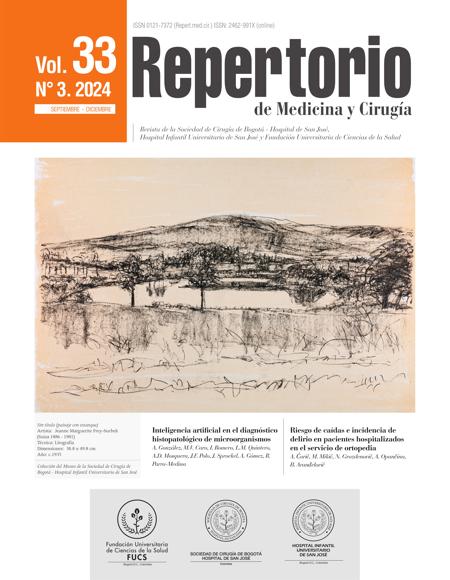Pathology of the placenta in hypertensive disorders of pregnancy and fetal growth restriction
Patología placentaria en restricción del crecimiento fetal y trastornos hipertensivos del embarazo
![]()
![]()

Show authors biography
Introduction: hypertensive disorders of pregnancy and fetal growth restriction are conditions which have a great impact, sharing their pathogenesis in abnormal placentation. The histological study of the placenta allows understanding part of these phenomena, besides having academic, medical, and legal implications. Objective: to characterize placental anatomopathological findings in women diagnosed with hypertensive disorders of pregnancy and/or fetal growth restriction in a high complexity hospital in Popayán, Colombia. Methods: a cross-sectional observational study, including a population of women who during their pregnancy were diagnosed with fetal growth restriction and / or hypertensive disorders, between 2019 and 2020, in whom a placental anatomopathological examination was performed. Results: of the 155 cases analyzed, 99.35% evidenced maternal vascular malperfusion, 70.97% fetal vascular malperfusion, 4.52% delayed villous maturation, and.35% inflammation. Conclusions: this study revealed high prevalence of abnormal histopathological findings which correlate to those reported in the literature.
Article visits 441 | PDF visits 244
Downloads
- World Health Organization. Objetivos de Desarrollo Sostenible: Metas. World Health Organization; 2015 [cited 2019 Dec 4]; Available from: https://www.who.int/data/gho/data/themes/world-health-statistics
- Martínez Sánchez LM, Rodríguez Gázquez ÁM, Mejía Ruiz C, Hernández Restrepo F, Quintero Moreno DA, Gómez Arango L. Perfil clínico y epidemiológico de pacientes con trastorno hipertensivo asociado al embarazo en Medellín, Colombia. Revista Cubana de Obstetricia y Ginecología. 2018;44(2):1-9.
- Bokslag A, Weissenbruch MV, Mol BW, M de Groot CJ. Preeclampsia; short and long-term consequences for mother and neonate. Early Hum Dev. 2016;102:47–50. https://doi.org/10.1016/j.earlhumdev.2016.09.007. DOI: https://doi.org/10.1016/j.earlhumdev.2016.09.007
- American College of Obstetricians and Gynecologists', Committee on Practice Bulletins Obstetrics and the Society forMaternal-FetalMedicin. ACOG Practice Bulletin No. 204: Fetal Growth Restriction. Obstet Gynecol. 2019;133(2):e97–109. https://doi.org/10.1097/AOG.0000000000003070. DOI: https://doi.org/10.1097/AOG.0000000000003070
- Verdugo-Muñoz LM, Alvarado-Llano JJ, Bastidas-Sánchez BE, Ortiz-Martínez RA. Prevalencia de restricción del crecimiento intrauterino en el Hospital Universitario San José, Popayán (Colombia), 2013. Rev. Colomb. Obstet. Ginecol. 2015;66(1):46-2. https://doi.org/10.18597/rcog.7 DOI: https://doi.org/10.18597/rcog.7
- Alonso-Remedios A, Pérez-Cutiño M, de León Delgado DF. Inmunopatogenia de la enfermedad hipertensiva gravídica. Rev Cuba Obstetr Ginecol. 2018;43(4):10-114
- Turco MY, Moffett A. Development of the human placenta. Development. 2019;146(22):dev163428. https://doi.org/10.1242/dev.163428. DOI: https://doi.org/10.1242/dev.163428
- Langston C, Kaplan C, Macpherson T, Manci E, Peevy K, Clark B, et al. Practice guideline for examination of the placenta: developed by the Placental Pathology Practice Guideline Development Task Force of the College of American Pathologists. Arch Pathol Lab Med. 1997;121(5):449–76.
- Prieto-Gómez R, Ottone NE, Sandoval-Vásquez C, Saavedra-S A, Bianchi HF. Aspectos morfocuantitativos de las vellosidades coriales libres en gestas normales, con diabetes, hipertensión arterial y restricción del crecimiento intrauterino. Int. J. Morphol. 2018;36(2):551-556. http://dx.doi.org/10.4067/S0717-95022018000200551 DOI: https://doi.org/10.4067/S0717-95022018000200551
- Khong TY, Mooney EE, Ariel I, Balmus NCM, Boyd TK, Brundler M-A, et al. Sampling and Definitions of Placental Lesions: Amsterdam Placental Workshop Group Consensus Statement. Arch Pathol Lab Med. 2016;140(7):698–713. http://dx.doi.org/10.5858/arpa.2015-0225-CC. DOI: https://doi.org/10.5858/arpa.2015-0225-CC
- Gordijn, S.J., Beune, I.M., Thilaganathan, B., Papageorghiou, A., Baschat, A.A., Baker, P.N., Silver, R.M., Wynia, K. and Ganzevoort, W. Consensus definition of fetal growth restriction: a Delphi procedure. Ultrasound Obstet Gynecol, 2016;48(3):333-339. http://dx.doi.org/10.1002/uog.15884. DOI: https://doi.org/10.1002/uog.15884
- Brown MA, Magee LA, Kenny LC, Karumanchi SA, McCarthy FP, Saito S, Hall DR, Warren CE, Adoyi G, Ishaku, S. The hypertensive disorders of pregnancy: ISSHP classification, diagnosis & management recommendations for international practice. Hypertension. 2018;72(1):24-43. http://dx.doi.org/10.1161/HYPERTENSIONAHA.117.10803. DOI: https://doi.org/10.1161/HYPERTENSIONAHA.117.10803
- Thompson JM, Irgens LM, Skjaerven R, Rasmussen S. Placenta weight percentile curves for singleton deliveries. BJOG. 2007;114(6):715–720. http://dx.doi.org/10.1111/j.1471-0528.2007.01327.x. DOI: https://doi.org/10.1111/j.1471-0528.2007.01327.x
- Eskild A, Haavaldsen C, Vatten LJ. Placental weight and placental weight to birthweight ratio in relation to Apgar score at birth: a population study of 522 360 singleton pregnancies. Acta Obst Gynecol Scand. 2014;93(12):1302–1308. http://dx.doi.org/10.1111/aogs.12509. DOI: https://doi.org/10.1111/aogs.12509
- Sehgal A, Dahlstrom JE, Chan Y, Allison BJ, Miller SL, Polglase GR. Placental histopathology in preterm fetal growth restriction. J Paediatr Child Health. 2019;55(5):582-587. http://dx.doi.org/10.1111/jpc.14251. DOI: https://doi.org/10.1111/jpc.14251
- Sánchez-Cobo D, Copado-Mendoza DY, Valdespino-Vázquez MY, Rodríguez-Sibaja MJ, Acevedo-Gallegos S. Cambios morfológicos en las placentas de pacientes con preeclampsia o restricción del crecimiento intrauterino e interpretación de los desenlaces perinatales. Ginecol Obstet Méx. 2021;89(11):875-883. https://doi.org/10.24245/gom.v89i11.4944. DOI: https://doi.org/10.24245/gom.v89i11.4944
- Fillion A, Guerby P, Menzies D, Lachance C, Comeau MP, Bussières MC, Bujold E. Pathological investigation of placentas in preeclampsia (the PEARL study). Hypertens Pregnancy. 2021;40(1):56–62. https://doi.org/10.1080/10641955.2020.1866008. DOI: https://doi.org/10.1080/10641955.2020.1866008
- Levy M, Kovo M, Schreiber L, Kleiner I, Koren L, Barda G, Weiner E. Pregnancy outcomes in correlation with placental histopathology in subsequent pregnancies complicated by preeclampsia. Pregnancy Hypertens. 2019;18:163–168. http://dx.doi.org/10.1016/j.preghy.2019.09.021. DOI: https://doi.org/10.1016/j.preghy.2019.09.021
- Ditisheim A, Sibai B, Tatevian N. Placental Findings in Postpartum Preeclampsia: A Comparative Retrospective Study. Am J Perinatol. 2020;37(12):1217-1222. http://dx.doi.org/10.1055/s-0039-1692716. DOI: https://doi.org/10.1055/s-0039-1692716
- Weiner E, Schreiber L, Grinstein E, Feldstein O, Rymer-Haskel N, Bar J, Kovo M. The placental component and obstetric outcome in severe preeclampsia with and without HELLP syndrome. Placenta. 2016;47:99–104. http://dx.doi.org/10.1016/j.placenta.2016.09.01. DOI: https://doi.org/10.1016/j.placenta.2016.09.012
- Hwa Im D, Kim YN, Cho HJ, Park YH, Kim DH, Byun JM, Sung MS. Placental Pathologic Changes Associated with Fetal Growth Restriction and Consequent Neonatal Outcomes. Fetal Pediatr Pathol. 2021;40(5):430-441. http://dx.doi.org/10.1080/15513815.2020.1723147. DOI: https://doi.org/10.1080/15513815.2020.1723147
- Yaguchi C, Itoh H, Tsuchiya KJ, Furuta-Isomura N, Horikoshi Y, Matsumoto M, Kanayama N. Placental pathology predicts infantile physical development during first 18 months in Japanese population: Hamamatsu birth cohort for mothers and children (HBC Study). Plos One, 2018;13(4):e0194988. http://dx.doi.org/10.1371/journal.pone.0194988. DOI: https://doi.org/10.1371/journal.pone.0194988
- Ueda M, Tsuchiya KJ, Yaguchi C, Furuta-Isomura N, Horikoshi Y, et al. Placental pathology predicts infantile neurodevelopment. Sci Rep. 2022;12(1):2578. http://dx.doi.org/10.1038/s41598-022-06300-w. DOI: https://doi.org/10.1038/s41598-022-06300-w












